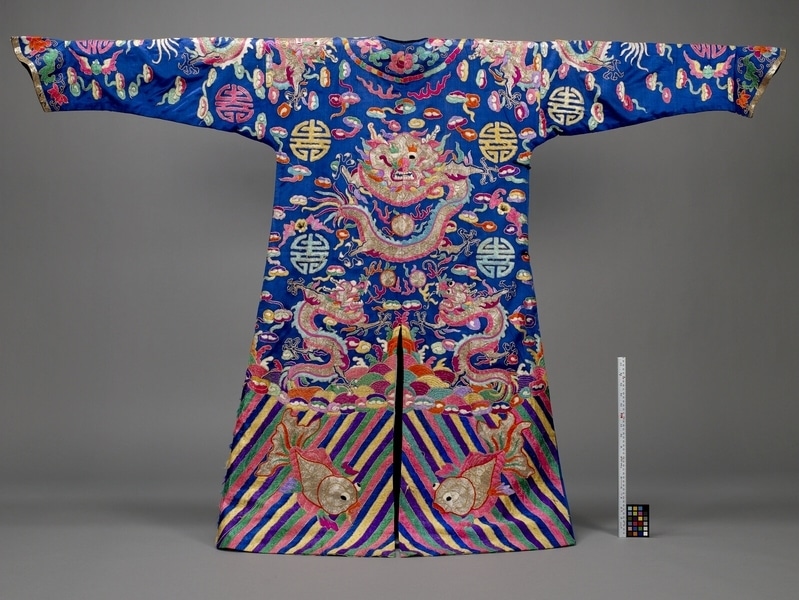Cantonese Opera Robe Item Number: N1.649 from the MOA: University of British Columbia


Description
Manchu-style mang (python robe). Blue coloured robe with slender sleeves, hoof cuffs, front and back slits and side opening with brass frog fasteners. Dragon, fish, wave, mountain and cloud motifs and longevity symbol on the front and back, in gold, pink, yellow, green and purple on medium blue ground. Collar and sleeve bands have peony motifs in pink, orange, mauve and green on medium blue ground. The inside lining is white linen.
History Of Use
Manchu-style costumes such as this one reflect their nomadic origins as horse riders, in contrast to the village-bound farmers of Han Chinese culture. The Manchu-style mang (python robe), fashioned after actual Qing dynasty court robes, has tight sleeves that flare into tapered “horse hoof” cuffs at the wrists to protect a rider’s hands from the elements. The high slits in the middle are features designed to make it easy to mount and dismount a horse. Usually is paired with a matching cap.
Iconographic Meaning
The identification of the costume is indicated by its shape, and by the dragon and wave pattern at the bottom.
Cultural Context
theatre
Specific Techniques
Embroidery is done with long satin stitches, following a pattern marked on the fabric. Seams are invisible except for those at centre back and collar, which are done by hand. Fabric was woven with silk warp and cotton weft, or vice versa.
Narrative
A large group of Cantonese opera costumes, musical instruments, props, trunks, and stage fittings was left with the Jin Wah Sing Musical Association, apparently by some of the many itinerant troupes visiting Vancouver to perform in the Chinatown theatres in the pre-World War II period. There is no certain knowledge of why these materials were not taken back to China by them. They were used by the Jin Wah Sing Musical Association in their performances until they became too dated. The association continued to preserve them carefully, storing them in their headquarters and in the basement of the Chinese Freemasons building until several groups of materials were sold and donated to the Museum of Anthropology.
Item History
- Made by Leuhn Cheung Gam Leuhn Cheung (Manufacturer) in Guangzhou, Guangdong, China during 1910
- Collected in Vancouver, British Columbia, Canada
- Owned by Jin Wah Sing Musical Association before August 28, 1973
- Received from Barrett Montford Endowment Fund (Funding source), Jin Wah Sing Musical Association (Seller), Leon & Thea Koerner Foundation (Funding source), Museum of Anthropology Donations Fund (Funding source), Mah Society of North America (Funding source), Canada-China Friendship Association (Funding source), Quon H. Wong Agencies (Funding source) and Edith Low-Beer (Funding source) on August 28, 1973
What
- Name
- Cantonese Opera Robe
- Identification Number
- N1.649
- Type of Item
- robe
- Material
- silk fibre, cotton fibre, hemp fibre, gold metal, silver metal and brass metal
- Manufacturing Technique
- dyed, woven, sewn, embroidered, drawn and couched
- Overall
- height 137.0 cm, width 194.0 cm
Who
- Culture
- Chinese: Cantonese
- Creator
- Leuhn Cheung Gam Leuhn Cheung (Manufacturer)
- Previous Owner
- Jin Wah Sing Musical Association
- Received from
- Barrett Montford Endowment Fund (Funding source), Jin Wah Sing Musical Association (Seller), Leon & Thea Koerner Foundation (Funding source), Museum of Anthropology Donations Fund (Funding source), Mah Society of North America (Funding source), Canada-China Friendship Association (Funding source), Quon H. Wong Agencies (Funding source) and Edith Low-Beer (Funding source)
Where
- Holding Institution
- MOA: University of British Columbia
- Made in
- Guangzhou, Guangdong, China
- Collected in
- Vancouver, British Columbia, Canada
When
- Creation Date
- during 1910
- Ownership Date
- before August 28, 1973
- Acquisition Date
- on August 28, 1973
Other
- Item Classes
- textiles
- Condition
- good
- Accession Number
- 0248/0034